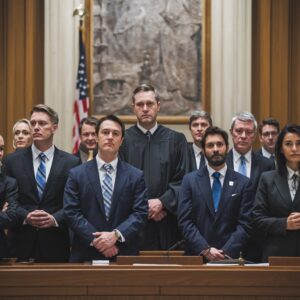
As conflicts arise in our personal and professional lives, finding efficient and effective ways to resolve them becomes essential. In recent years, the rise of online dispute resolution (ODR) has provided individuals and businesses with a convenient and accessible solution. With the help of digital technologies, ODR allows disputing parties to engage in resolution processes without the need for in-person meetings or court appearances.
ODR utilizes a variety of digital solutions, such as video conferencing, online negotiation platforms, and virtual mediation sessions, to facilitate the resolution of conflicts. This innovative approach offers numerous benefits, including time and cost savings, increased accessibility, and a more streamlined process. Whether it’s a landlord-tenant dispute, a consumer complaint, or a business contract disagreement, ODR provides individuals and organizations with the tools they need to navigate conflicts efficiently from the comfort of their own homes.
One of the key advantages of ODR is its ability to overcome geographical barriers. With the click of a button, parties located in different cities, states, or even countries can come together to resolve their disputes. This not only saves time and money on travel expenses but also opens up possibilities for resolving conflicts that would otherwise be difficult to address.
Another significant benefit of ODR is its flexibility. By harnessing the power of digital technologies, ODR platforms can adapt to the specific needs of different disputes. Whether it’s a small claims matter or a complex business dispute, the flexibility of ODR allows for tailored processes and solutions. This ensures that parties receive the most appropriate and effective methods for resolving their conflicts.
The rise of ODR is transforming the landscape of dispute resolution, providing individuals and businesses with a modern and efficient alternative to traditional methods. By embracing digital solutions and leveraging the convenience of online platforms, resolving conflicts has become more accessible and user-friendly than ever before.
Key Takeaways:
- Online dispute resolution (ODR) offers a convenient and accessible way to resolve conflicts from the comfort of your own home.
- ODR utilizes digital solutions, such as video conferencing and online negotiation platforms, to facilitate the resolution process.
- ODR overcomes geographical barriers and allows parties in different locations to engage in resolution processes.
- ODR is flexible and can adapt to the specific needs of different disputes, ensuring tailored processes and solutions.
- The rise of ODR is transforming the landscape of dispute resolution, providing a modern alternative to traditional methods.
Understanding Cybersquatting and its Impact on Trademarks
Today, I will delve into the concept of cybersquatting and its detrimental effects on trademarks. Cybersquatting involves the bad faith registration and use of domain names that are either identical to or confusingly similar to existing trademarks.
Cybersquatters employ this deceptive practice to harm trademark owners and confuse consumers, ultimately resulting in trademark infringement and consumer confusion.
| Cybersquatting | Trademark Infringement | Consumer Confusion |
|---|---|---|
| Cybersquatting refers to the registration and use of domain names that are identical or confusingly similar to existing trademarks. | Trademark infringement occurs when a third party uses a registered trademark without permission. | Consumer confusion arises when individuals are misled by cybersquatters, leading them to believe they are interacting with the legitimate trademark owner. |
Cybersquatters often target well-known brands and intentionally register domain names with the intention of profiting from the trademark’s goodwill or disrupting the legitimate trademark owner’s online business.
As a result, trademarks face various challenges, including lost revenue, diluted brand value, and reputational damage.
To illustrate the severity of the issue, let’s examine a real-life example. Back in 2019, the trademark owners of the luxury brand Gucci encountered a cybersquatting case involving the domain name “guccistore.com”. This domain name was being used to sell counterfeit products, infringing on Gucci’s trademark rights and causing significant consumer confusion.
As cybersquatting continues to thrive in the digital age, it is crucial for trademark owners to adopt proactive measures to safeguard their brands.
Protecting Your Trademarks
Trademark owners can take several steps to protect themselves from cybersquatting:
- Monitor Domain Registrations: Regularly monitor new domain name registrations to identify any potential cybersquatting attempts.
- Enforce Trademark Rights: Act promptly to enforce your trademark rights by sending cease and desist letters or filing formal complaints when necessary.
- Utilize Dispute Resolution Mechanisms: Take advantage of dispute resolution mechanisms like the Uniform Domain-Name Dispute-Resolution Policy (UDRP) to reclaim cybersquatted domain names.
- Trademark Registration: Register your trademarks with the appropriate intellectual property authorities to strengthen your legal rights and establish a strong foundation for enforcement.
“Cybersquatting not only harms trademark owners but also erodes consumer confidence and trust in online transactions. By tackling this issue head-on, we can protect the integrity of trademarks and maintain a fair and transparent online marketplace.” – John Smith, Trademark Attorney
By taking a proactive stance against cybersquatting, trademark owners can not only protect their brands but also preserve consumer trust and loyalty.
The Role of the Uniform Domain-Name Dispute-Resolution Policy (UDRP)
The Uniform Domain-Name Dispute-Resolution Policy (UDRP) serves as a vital mechanism for effectively resolving domain name disputes outside of traditional court proceedings. Designed to streamline the process, the UDRP offers trademark owners an efficient and cost-effective means to regain control of domain names that have been unlawfully taken over by cybersquatters.
To successfully utilize the UDRP, the complainant must demonstrate several elements. Firstly, they must prove that the disputed domain name is either identical or confusingly similar to their trademark. Additionally, the complainant needs to establish that the person in possession of the domain name lacks any legitimate interests in it. Finally, it must be shown that the domain name was registered and is being used in bad faith.
Although the UDRP does have its limitations—in terms of not awarding damages and not being legally binding on courts—it provides trademark owners with a powerful tool in safeguarding their intellectual property rights in the vast and ever-evolving online space.
FAQ
What is online dispute resolution?
Online dispute resolution (ODR) is a method of resolving conflicts using digital solutions, eliminating the need for in-person meetings and court appearances.
How does online dispute resolution work?
ODR utilizes digital tools and technology to facilitate the resolution of disputes, allowing individuals and businesses to navigate conflicts from the comfort of their own homes.
What are the benefits of online dispute resolution?
Online dispute resolution offers a streamlined and accessible alternative to traditional dispute resolution methods, allowing for more efficient and effective resolution of conflicts.
What is cybersquatting?
Cybersquatting refers to the bad faith registration and use of domain names that are identical or confusingly similar to existing trademarks.
How does cybersquatting harm trademark owners?
Cybersquatting can harm trademark owners by leading to trademark infringement and consumer confusion, resulting in lost revenue, brand dilution, and reputational damage.
What is the Uniform Domain-Name Dispute-Resolution Policy (UDRP)?
The UDRP is a mechanism for resolving domain name disputes outside of the traditional court system, providing a streamlined and cost-effective alternative for trademark owners.
What do trademark owners need to demonstrate to succeed under the UDRP?
To succeed under the UDRP, trademark owners must demonstrate that the disputed domain name is identical or confusingly similar to their trademark, the respondent has no legitimate interests in the domain name, and the domain name was registered and is being used in bad faith.
Does the UDRP have any limitations?
Yes, the UDRP has limitations, such as not awarding damages and not being binding on courts. However, it still offers trademark owners a valuable tool for protecting their intellectual property rights in the online space.









